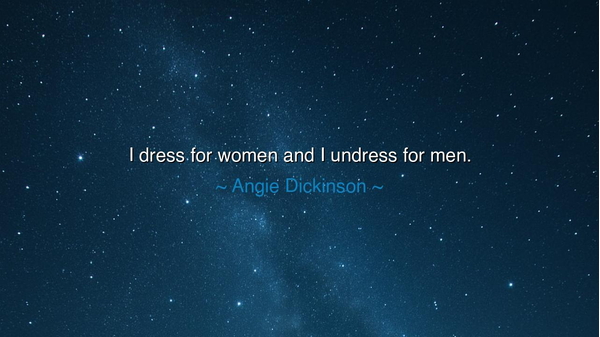
I dress for women and I undress for men.






The words of Angie Dickinson, “I dress for women and I undress for men,” are both playful and profound. Beneath their surface lies the recognition of two truths: that the art of adornment is often a dialogue between women themselves, while the unveiling of beauty has long been bound to the gaze of men. Her words capture the duality of womanhood in a world where identity is both self-fashioned and externally desired.
In the ancient spirit, this saying recalls the practices of queens and priestesses. To dress was not merely to cover, but to proclaim power, status, and identity. Cleopatra’s garments dazzled not only Rome’s men but Egypt’s women, who saw in her attire a symbol of sovereignty and divine authority. Adornment was, and remains, a language spoken among women, each thread a declaration of confidence, rivalry, or sisterhood.
Yet, Dickinson also acknowledges the age-old truth that women’s bodies have been drawn into the theater of desire. To undress is not only the act of intimacy, but also the surrender to society’s expectation that women be the objects of men’s gaze. Her words, then, are both ironic and candid: women craft their elegance in communion with each other, but the world has taught them to strip that elegance away in service to men.
History bears witness in the salons of Marie Antoinette, where her gowns and hairstyles became the envy and obsession of women across France. She dressed to impress her peers, to maintain her place in the hierarchy of fashion and courtly life. Yet beyond the palace walls, her persona was reduced in pamphlets and propaganda to a figure of scandal, where her body, not her attire, was the focus of men’s judgment. Dickinson’s quote lives in this same paradox.
So let this wisdom endure: the act of dressing and undressing has never been merely about cloth or skin, but about power, identity, and perception. Dickinson’s words remind us that women are often caught between worlds—the one where they shape themselves for each other in strength and creativity, and the one where they are reduced to objects of men’s desire. To understand this is to glimpse the ancient struggle of womanhood: to be both the author of one’s own beauty and the captive of another’s gaze.






KLTran Khanh Linh
Angie Dickinson’s quote could be seen as a critique of the way women’s appearances are often dictated by others’ expectations. But is there also an empowering side to this? Could it be that dressing for women is a form of solidarity or self-expression, and undressing for men might be more about personal choice and confidence rather than objectification? Where does one draw the line between pleasing others and staying true to oneself?
NTNgoc Tram
This quote feels like it captures a certain duality in how women are taught to navigate the world. On the one hand, they dress in a way that fits in with other women, creating a sense of belonging, while on the other, they may undress for men, perhaps seeking validation or attention. I wonder—how much of this behavior is learned, and could there be a shift where women no longer feel compelled to play these roles for others?
TTThao Thinh
I find Angie Dickinson’s quote to be a revealing commentary on societal expectations. It raises the question of how much women’s fashion is shaped by the male gaze versus the desire to impress other women. Do we ever dress purely for ourselves, without worrying about how others will perceive us? What would it look like if women could entirely free themselves from these influences and dress solely for personal satisfaction?
DK7E-Phan Duong Khoi
The quote by Angie Dickinson is interesting, as it seems to reflect the idea that women often face societal pressure from both genders—women may dress for each other, while men may influence how they undress. I wonder—does this imply that women’s choices in appearance are largely driven by external forces, or is there a deeper personal satisfaction in making choices based on what others expect? Is true autonomy in self-expression even possible?
MTMai Trang
This quote speaks to the complexities of how we present ourselves in society. Angie Dickinson seems to be highlighting the way women often tailor their appearances based on different expectations—pleasing other women through style and impressing men through attraction. But does this mean women are always dressing for someone else, and never for themselves? How much of our personal style is really for our own satisfaction versus how we are perceived by others?